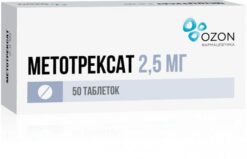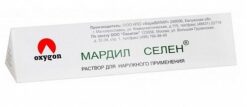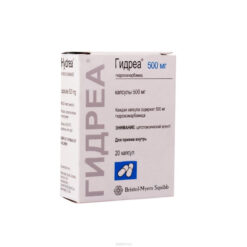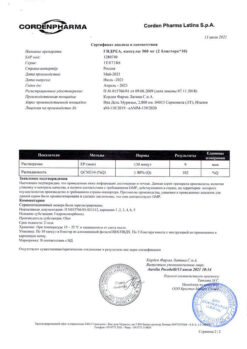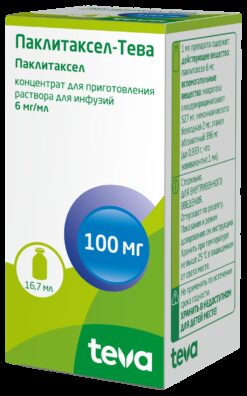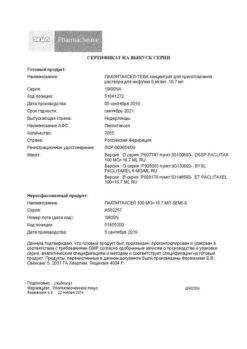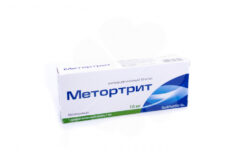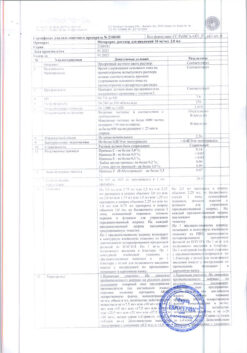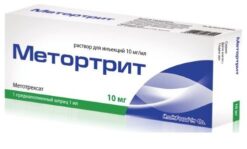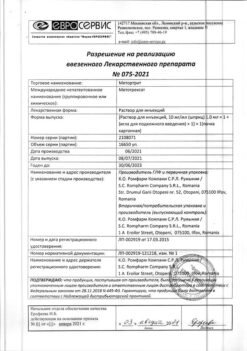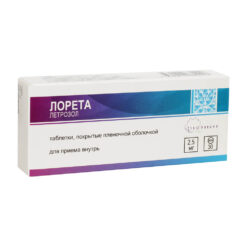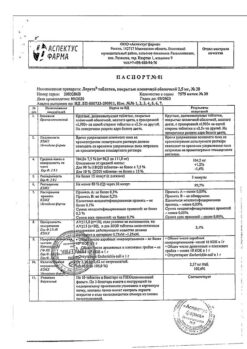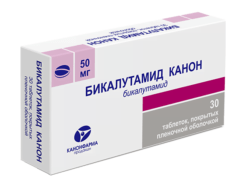No products in the cart.
Description
Rituximab is a chimeric mouse/human monoclonal antibody that binds specifically to the transmembrane antigen CD20. This antigen is located on pre-B-lymphocytes and mature B-lymphocytes, but is absent on hematopoietic stem cells, pre-B cells, normal plasma cells, cells of other tissues and is expressed in more than 95% of B-cell non-Hodgkin lymphomas.
CD20 expressed on the cell after binding to the antibody is not internalized and ceases to enter the extracellular space from the cell membrane. CD20 does not circulate in plasma as a free antigen and therefore does not compete for binding to antibodies.
Rituximab binds to the CD20 antigen on B-lymphocytes and initiates immunological reactions mediating B-cell lysis. Possible mechanisms of cell lysis include complement-dependent cytotoxicity, antibody-dependent cellular cytotoxicity, and apoptosis induction. Rituximab increases the sensitivity of human B-cell lymphoma cell lines to the cytotoxic effects of some chemotherapeutic agents in vitro.
B-cell counts in peripheral blood decrease below normal after the first drug administration and begin to recover in patients with hematological malignancies after 6 months, reaching normal values after 9-12 months after completion of therapy.
Antibodies to rituximab were not detected in 67 patients examined during treatment of CD20-positive B-cell non-Hodgkin’s lymphoma with Redditux®.
Pharmacokinetics:
Non-Hodgkin’s Lymphoma
In patients with recurrent B-cell lymphoma, the serum concentration of rituximab and its half-life (T1/2) increase with increasing dose. After the first intravenous infusion of 375 mg/m2, the T1/2 of rituximab was 76.3 h and 205.8 h after the fourth infusion; maximum concentration (Cmax) was 205.6 µg/mL after the first infusion and 464.7 µg/mL after the fourth infusion; plasma clearance was 0.0382 L/h and 0.0092 L/h, respectively. Individual differences in serum concentrations of the drug are quite pronounced.
With effective treatment, serum concentrations of rituximab are significantly higher. Drug concentrations are negatively correlated with tumor burden. Traces of rituximab can be detected in the body for 3-6 months after the last infusion.
In patients with diffuse B-cell lymphoma, serum concentrations of rituximab are comparable to those of patients with non-Hodgkin’s lymphoma of low malignancy or follicular lymphoma receiving the same doses of the drug.
Pharmacokinetics in selected patient groups
Gender. The volume of distribution and clearance of rituximab adjusted for body surface area is slightly greater in males than in females, no adjustment of rituximab dose is required.
Patients with renal and hepatic impairment. There are no pharmacokinetic data in patients with renal and hepatic impairment.
Indications
Indications
Non-Hodgkin’s lymphoma:
– relapsed or chemoresistant B-cell, CD20-positive low-grade or follicular non-Hodgkin lymphoma;
– stage III-IV follicular lymphoma in combination with chemotherapy in previously untreated patients;
– follicular lymphoma as maintenance therapy after response to induction therapy;
– CD20-positive diffuse large B-cell non-Hodgkin lymphoma in combination with chemotherapy according to the CHOP regimen.
Chronic lymphocytic leukemia:
Chronic lymphocytic leukemia in combination with chemotherapy in patients who have not previously received standard therapy.
Recurrent or chemoresistant chronic lymphocytic leukemia in combination with chemotherapy.
Pharmacological effect
Pharmacological effect
Rituximab is a mouse/human chimeric monoclonal antibody that specifically binds to the CD20 transmembrane antigen. This antigen is located on pre-B lymphocytes and mature B lymphocytes, but is absent on hematopoietic stem cells, pre-B cells, normal plasma cells, cells of other tissues and is expressed in more than 95% of cases of B-cell non-Hodgkin lymphoma.
CD20 expressed on the cell after binding to the antibody is not internalized and ceases to flow from the cell membrane into the extracellular space. CD20 does not circulate in plasma as a free antigen and therefore does not compete for antibody binding.
Rituximab binds to the CD20 antigen on B cells and initiates immunological responses that mediate B cell lysis. Possible mechanisms of cell lysis include complement-dependent cytotoxicity, antibody-dependent cellular cytotoxicity, and induction of apoptosis. Rituximab sensitizes human B-cell lymphoma lines to the cytotoxic effects of certain chemotherapeutic drugs in vitro.
The number of B cells in the peripheral blood after the first administration of the drug decreases below normal and begins to recover in patients with hematological malignancies after 6 months, reaching normal values 9-12 months after completion of therapy.
Antibodies to rituximab were not detected in 67 patients examined during the treatment of CD20-positive B-cell non-Hodgkin lymphoma with Redditux®.
Pharmacokinetics:
Non-Hodgkin’s lymphoma
In patients with relapsed B-cell lymphoma, the serum concentration of rituximab and its half-life (T1/2) increase with increasing dose. After the first intravenous infusion of 375 mg/m2 T1/2 rituximab – 76.3 hours, after the fourth infusion – 205.8 hours, maximum concentration (Cmax) after the first infusion 205.6 mcg/ml, after the fourth infusion – 464.7 mcg/ml, plasma clearance – 0.0382 l/h and 0.0092 l/h respectively. Individual differences in the serum concentration of the drug are quite pronounced.
With effective treatment, serum concentrations of rituximab were significantly higher. The concentration of the drug negatively correlates with the magnitude of the tumor load. Traces of rituximab can be detected in the body for 3-6 months after the last infusion.
In patients with diffuse large B-cell lymphoma, serum concentrations of rituximab are comparable to those in patients with low-grade or follicular non-Hodgkin lymphoma receiving the same doses of the drug.
Pharmacokinetics in selected patient groups
Floor. The volume of distribution and clearance of rituximab, adjusted for body surface area, is slightly greater in men than in women; no dose adjustment of rituximab is required.
Patients with renal and liver failure. Pharmacokinetic data in patients with renal and hepatic impairment are not available.
Special instructions
Special instructions
The drug Redditux® is administered under the close supervision of an oncologist or hematologist, if the necessary conditions for resuscitation are available.
Infusion reactions
The development of infusion reactions may be due to the release of cytokines and/or other mediators. Severe infusion reactions are difficult to distinguish from hypersensitivity reactions or cytokine release syndrome. There are reports of fatal infusion reactions described during post-marketing use of rituximab. Most patients develop fever with chills or trembling within 30 minutes to 2 hours after starting the first rituximab infusion.
Severe reactions include pulmonary symptoms, low or high blood pressure, urticaria, angioedema, nausea, vomiting, weakness, headache, itching, irritation of the tongue or swelling of the throat (vascular edema), rhinitis, hot flashes, localized pain, and, in some cases, signs of rapid tumor lysis syndrome. Infusion reactions disappear after interrupting the administration of rituximab and drug therapy (intravenous administration of 0.9% sodium chloride solution, diphenhydramine and acetaminophen, bronchodilators, glucocorticosteroids, etc.).
In most cases, after complete resolution of symptoms, the infusion can be resumed at a rate of 50% of the previous rate (eg, 50 mg/hour instead of 100 mg/hour). In the majority of patients with non-life-threatening infusion reactions, the course of treatment with rituximab was completely completed. Continuation of therapy after complete disappearance of symptoms is rarely accompanied by recurrence of severe infusion reactions.
Due to the potential for the development of anaphylactic reactions and other hypersensitivity reactions with intravenous administration of protein drugs, it is necessary to have means to relieve them: epinephrine, antihistamines and glucocorticosteroid drugs.
It is recommended to premedicate (analgesics and antihistamines) 30-60 minutes before each infusion. The prepared solution for infusion cannot be administered as a stream.
Side effects from the lungs
Symptoms may worsen over time or clinical deterioration may occur after initial improvement. Patients with pulmonary symptoms or other severe infusion reactions should be closely monitored until symptoms resolve completely. Acute respiratory failure may be accompanied by the formation of interstitial infiltrates in the lungs or pulmonary edema, often manifesting itself in the first 1-2 hours after the start of the first infusion. If severe reactions from the lungs develop, the rituximab infusion should be stopped immediately and intensive symptomatic therapy should be prescribed. Since initial improvement in clinical symptoms may be followed by worsening, patients should be carefully monitored until pulmonary symptoms resolve.
Rapid tumor lysis syndrome
Rituximab mediates rapid lysis of benign or malignant CD20-positive cells. Tumor lysis syndrome is possible after the first infusion of rituximab in patients with a large number of circulating malignant lymphocytes. Tumor lysis syndrome includes: hyperuricemia, hyperkalemia, hypocalcemia, hyperphosphatemia, acute renal failure, increased LDH activity. Patients at risk (patients with a high tumor burden or a large number of circulating malignant cells (> 25 x 109/L), for example with chronic lymphocytic leukemia or mantle cell lymphoma) require careful medical supervision and regular laboratory examination. If symptoms of rapid tumor lysis develop, appropriate therapy is administered.
After complete relief of symptoms in a limited number of cases, rituximab therapy is continued in combination with the prevention of rapid tumor lysis syndrome. Considerations for prescribing the drug to patients with a large number of circulating malignant cells (> 25 x 109/L) or a high tumor burden (for example, with chronic lymphocytic leukemia or mantle cell lymphoma), in whom the risk of extremely severe infusion reactions may be especially high, Redditux® should be prescribed with extreme caution, under close monitoring. The first infusion of the drug in such patients should be administered at a slower rate or the dose of Redditux® should be divided into two days during the first cycle of therapy and in each subsequent cycles if the number of circulating malignant cells remains >25 x 109/L.
Side effects from the cardiovascular system
During infusion, careful monitoring of patients with a history of cardiovascular disease is required due to the possibility of low blood pressure, angina pectoris or arrhythmia (atrial flutter and fibrillation). Due to the possibility of hypotension, antihypertensive medications should be discontinued at least 12 hours before the Redditux® infusion.
Control of blood cells
Although rituximab monotherapy does not have a myelosuppressive effect, caution should be exercised when prescribing Redditux® for neutropenia less than 1.5 x 109/L and/or thrombocytopenia less than 75 x 109/L, since experience with its clinical use in such patients is limited. Rituximab has been used in patients after autologous bone marrow transplantation and in other risk groups with possible impairment of bone marrow function, without causing myelotoxicity. During treatment, it is necessary to regularly determine a detailed peripheral blood count, including platelet count, in accordance with routine practice.
Infections
Redditux® should not be used in patients with severe acute infection.
Hepatitis B
When prescribing a combination of rituximab with chemotherapy, exacerbation of hepatitis B or fulminant hepatitis (including fatal outcomes) was observed. Predisposing factors included both the stage of the underlying disease and cytotoxic chemotherapy.
Before prescribing Redditux® to patients at risk, hepatitis B should be excluded. When prescribing Redditux® to patients who are carriers of the hepatitis B virus and patients with a history of hepatitis B, it is necessary to carefully monitor the occurrence of clinical and laboratory signs of active hepatitis B, both during therapy and for several months after its end.
Progressive multifocal leukoencephalopathy (PML)
Cases of PML have been observed with the use of rituximab in patients with non-Hodgkin’s lymphoma and chronic lymphocytic leukemia. Most patients received rituximab in combination with chemotherapy or in combination with hematopoietic stem cell transplantation. If neurological symptoms occur in such patients, it is necessary to conduct a differential diagnosis to exclude PML and consult a neurologist.
Immunization
The safety and effectiveness of immunization with live viral vaccines following treatment with rituximab have not been studied. Vaccination with live viral vaccines is not recommended. Vaccination with inactivated vaccines is possible, but response rates may be reduced.
Impact on the ability to drive vehicles. Wed and fur.:
It is unknown whether the drug Redditux® affects the ability to drive and work with machines and mechanisms, but given the safety profile of the drug and the presence of side effects from the nervous system, attention should be paid to the possible effect of the drug on the above functions.
Active ingredient
Active ingredient
Rituximab
Composition
Composition
1 ml of the drug contains:
active ingredient:
rituximab – 10.00 mg;
excipients:
sodium citrate dihydrate – 7.35 mg,
sodium chloride – 9.00 mg,
polysorbate 80 – 0.70 mg,
water for injections up to 1.00 ml.
Pregnancy
Pregnancy
There are no adequate data from controlled studies in pregnant women, but transient B cell depletion and lymphocytopenia have been observed in some infants whose mothers received rituximab during pregnancy. Therefore, rituximab should not be prescribed to pregnant women unless the potential benefits of therapy outweigh the potential risks.
It is not known whether rituximab is excreted in breast milk. Given that immunoglobulins G (IgG) circulating in the mother’s blood are excreted in breast milk, rituximab should not be used during breastfeeding.
IgG is able to penetrate the placental barrier. The level of B cells in newborns has not been studied when rituximab is prescribed to women during pregnancy.
During the treatment period and for 12 months after the end of treatment with the drug, women of childbearing age should use effective methods of contraception.
Contraindications
Contraindications
– Hypersensitivity to rituximab or other components of the drug, or mouse proteins;
– acute infectious diseases;
– severe primary or secondary immunodeficiency;
– children under 18 years of age (efficacy and safety have not been proven);
– pregnancy and breastfeeding.
With caution:
History of respiratory failure or tumor infiltration of the lungs; number of circulating malignant cells > 25 x 109/L or high tumor burden; neutropenia (less than 1.5 x 109/l); thrombocytopenia (less than 75 x 109/l), chronic infections.
Side Effects
Side Effects
Infusion reactions: chills, weakness, shortness of breath, dyspepsia, nausea, rash, hot flashes, fever, itching, urticaria, rhinitis, tachycardia, vomiting, pain, signs of tumor lysis syndrome. In some cases, during the R-CHOP regimen: myocardial infarction, atrial fibrillation and pulmonary edema.
Infections: respiratory tract infections – nasopharyngitis, sinusitis; bronchitis, pneumonia, lung superinfections; urinary tract infections, sepsis, herpes zoster, septic shock, implant infection, staphylococcal septicemia, reactivation of hepatitis B virus, fungal infections, infections of unknown etiology.
From the blood and lymphatic system: leukopenia, neutropenia, thrombocytopenia, anemia, febrile neutropenia, lymphadenopathy, bleeding disorders, pancytopenia (4 weeks or more after the last administration of rituximab), transient increase in IgM levels in patients with Waldenström’s macroglobulinemia, followed by a return to its original value after 4 months; transient partial aplastic anemia, hemolytic anemia.
From the respiratory system: rhinitis, mucous discharge from the nose, bronchospasm, cough or increased cough, respiratory disease, shortness of breath, acute respiratory failure, pulmonary infiltrates; hypoxia, impaired pulmonary function, bronchiolitis obliterans, bronchial asthma.
From the body as a whole, reactions at the injection site: pharyngeal irritation, angioedema, back pain, chest pain, neck pain, pain in tumor foci, flu-like syndrome, peripheral edema, mucositis, fainting, weight loss, multiple organ failure, rapid tumor lysis syndrome, serum sickness; abdominal enlargement, pain at the injection site, anaphylactic reactions.
From the gastrointestinal tract: dyspepsia, nausea, vomiting, diarrhea, lack of appetite, dysphagia, stomatitis, constipation, perforation of the stomach and/or intestines (possibly fatal), abdominal pain.
From the cardiovascular system: decrease and/or decrease in blood pressure (including as a reaction to administration), orthostatic hypotension, tachycardia, bradycardia, arrhythmia (including ventricular and supraventricular tachycardia, atrial fibrillation), unstable angina, vasodilation, venous thrombosis, incl. deep vein thrombosis of the extremities, heart failure, decreased ejection fraction, pulmonary edema, myocardial infarction, vasculitis, mainly cutaneous (leukocytoclastic), ischemic cerebrovascular accident.
From the nervous system: dizziness, headache, paresthesia, hypoesthesia, migraine, neuropathy of the cranial nerves, in combination with peripheral neuropathy or without it (marked decrease in visual acuity, hearing, damage to other sensory organs, paralysis of the facial nerve) during various periods of therapy – up to several months after completion of the course of treatment with rituximab, sleep disturbance, agitation.
From the mental sphere: confusion, nervousness, depression, anxiety, perversion of taste.
From the musculoskeletal system: myalgia, arthralgia, muscle hypertonicity, muscle spasms, osteoarthritis.
From the endocrine system: hyperglycemia, decompensation of diabetes mellitus.
From the skin and its appendages: itching, rash, urticaria, increased sweating at night, sweating, alopecia, severe bullous reactions, toxic epidermal necrolysis with a fatal outcome.
From the senses: impaired lacrimation, conjunctivitis, pain and tinnitus.
From laboratory parameters: decreased concentration of immunoglobulin G (IgG), increased activity of lactate dehydrogenase (LDH), hypocalcemia, hyperglycemia, hypercholesterolemia, bacteremia.
Special categories of patients
High tumor load (diameter of single lesions more than 10 cm). Increased frequency of grade 3-4 adverse reactions.
Elderly (over 65 years): The frequency and severity of all side effects and grade 3 and 4 side effects are no different from those in younger patients.
Repeated therapy: the frequency and severity of all side effects do not differ from those during initial therapy.
Interaction
Interaction
When used with other monoclonal antibodies for diagnostic or therapeutic purposes in patients who have antibodies to mouse proteins or anti-chimeric antibodies, the risk of allergic reactions increases.
When prescribed with cyclophosphamide, doxorubicin, vincristine, prednisolone, no increase in the incidence of toxic effects was observed.
Medicines that inhibit bone marrow hematopoiesis increase the risk of myelosuppression.
Redditux® is compatible with polyvinyl chloride or polyethylene infusion systems or bags.
Overdose
Overdose
Cases of overdose in humans have not been observed. Single doses of rituximab greater than 1000 mg have not been studied. The maximum dose of 5000 mg was prescribed to patients with chronic lymphocytic leukemia; no additional safety data were obtained.
Due to the increased risk of infectious complications when the B-lymphocyte pool is depleted, the drug should be discontinued or the rate of its infusion should be reduced; It is recommended to conduct a detailed general blood test.
Storage conditions
Storage conditions
At temperatures from 2 to 8 ° C. Do not freeze. Keep out of the reach of children.
Transportation conditions
At temperatures from 2 to 8 °C in thermal containers. Do not freeze.
Shelf life
Shelf life
2 years.
The drug should not be used after the expiration date indicated on the package.
Manufacturer
Manufacturer
R-Pharm JSC, Russia
Additional information
| Shelf life | 2 years. The product should not be used after the expiration date printed on the package. |
|---|---|
| Conditions of storage | Temperature of 2 to 8 ° C. Do not freeze. Keep out of the reach of children. Transport conditions At 2 to 8 °C in a thermocontainer. Do not freeze. . |
| Manufacturer | R-Pharm AO, Russia |
| Medication form | solution for infusion |
| Brand | R-Pharm AO |
Related products
Buy Redditux 10 mg/ml 10 ml with delivery to USA, UK, Europe and over 120 other countries.


